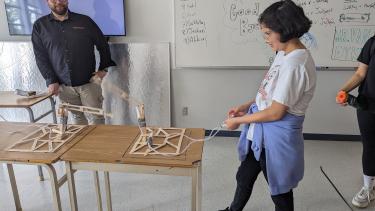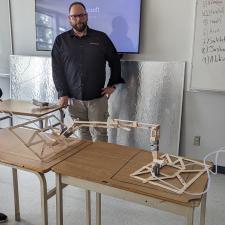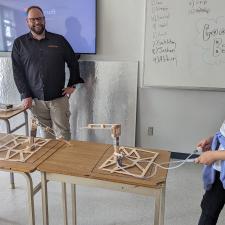
Engineering in Motion at ATS
At Abbotsford Traditional School, Lewis Van Dyk, had the opportunity to implement strong inquiry opportunities in the classroom in his first year at the school. In 2021 Abbotsford Traditional School first offered an Engineering 11 course. When Mr. Van Dyk took over the course, he focused on mechanical engineering and implementing the engineering design cycle through inquiry. Mr. Van Dyk focused on developing student design skills, as well as how simple machines work and the advantages that they have. From this, students were offered a wide variety of projects that would design and construct, including lifting platforms, gliders, articulated bridges, cranes, projectile launchers, projects of their own proposed design, and more.
By offering Engineering 11 in this way at Abbotsford Traditional School, two key goals of the Abbotsford School District strategic plan were being met, the first being to increase student achievement and inquiry, and the second, to promote excellence in teaching. Student inquiry was structured across several levels to meet students where they were at, giving them several opportunities to find structure and support in following the inquiry question to its conclusion. From student feedback and reflection, this inquiry was successful in developing student self-advocacy and student resilience as areas of growth of among the student participants at Abbotsford Traditional School. One piece of feedback Mr. Van Dyk noted was from a student who felt they were not very engaged with the academic work of secondary school, who said that they looked forward to this class, and made extra effort to attend because they were excited to what they were going to learn and build.
Mr. Van Dyk also prompted students to be reflective at every step of the engineering design cycle, stressing the applicability of this skill in wide range of careers and jobs. He noted, "Engineering 11 on its surface may not appear to be connected to BC’s core competencies, but students have learned how the engineering design cycle may contribute to personal growth, positive community impacts, learning to be stronger communicators, and deeper analytical thinkers.”
Mr. Van Dyk, a math teacher by training, offered the course with as low a math barrier as possible believing that the ideas of engineering which we use to develop technology in society can be intuited on several levels by rich, hands-on activities, which also included a field trip to Stave Lake Falls Power Generation Station. Mr. Van Dyk is looking forward to developing the course further in the future with an increased focus on student choice and voice, including community displays of learning.
REG GABRIEL, PRINCIPAL
Abbotsford Traditional School

